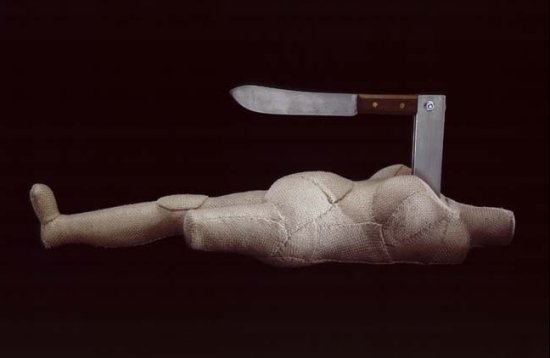Louise Bourgeois
dal 3/2/2003 al 1/3/2003
Segnalato da
3/2/2003
Louise Bourgeois
White Cube, London
''My childhood has never lost its magic, it has never lost its mystery, and it has never lost its drama. All my work of the last fifty years, all my subjects, have found their inspiration in my childhood.'' Louise Bourgeois

Opening Tuesday 4 February 6-8pm
"If I am in a positive mood, I'm interested in joining. If I'm in a negative mood, I will cut things."
"My childhood has never lost its magic, it has never lost its mystery, and it has never lost its drama. All my work of the last fifty years, all my subjects, have found their inspiration in my childhood."
Louise Bourgeois
Louise Bourgeois employs endlessly proliferating formal processes to destroy and rebuild the affective memory that is the source of the symbols and motifs of her artistic language. This seemingly inexhaustible process of self-revelation leaves in its wake a sculptural and graphic vocabulary of protean breadth and eloquence, much of the force of which derives from the dialectical tension between science and intuition at the core of this veteran artist's highly cultivated being.
Bourgeois began life in France at the beginning of the modern century, undergoing a classical French education based on seventeenth-century idealist philosophy with its emphasis on matters both metaphysical and mathematical. At the same time, she received an artistic apprenticeship of sorts in the family tapestry-restoration business, developing her natural aptitude for drawing by making cartoons for the missing fragments of damaged tapestries, and observing closely the daily reparations of the artisanal workshop. Initially studying mathematics, she was quickly drawn to the possibilities of art in the ferment of the radically subjective early modern era, with movements such as Cubism and Surrealism seeking to construct new ways of ordering reality.
She undertook her formal studies in Paris and later in New York, where she moved in 1938. Throughout her career Bourgeois has remained receptive to and conversant with the influences around her yet defiantly aloof in her existential solitude, a stance that has resulted in an oeuvre that has remained abreast of the concerns and values of the contemporary era. "What modern art means is that you have to keep finding new ways of expressing yourself, to express the problems, that there are no settled ways, no fixed approach. This is a painful situation, and modern art is about this painful situation of having absolutely no way of expressing yourself. This is why modern art will continue, because this condition remains. It is about the hurt of not being able to express yourself properly, to express your intimate relations, your unconscious, to trust the world enough to express yourself directly in it."
Recounting a painfully humiliating incident from her adolescence, Bourgeois indicates how making pain physical can be a way of controlling it: "My father cut the shape of a girl out of a tangerine peel, and then he held it up and said, 'Look everybody, this is Louise. She has nothing! All she's got between her legs is a couple of white threads!" Everybody laughed at me." Her riposte: "Once when we were sitting together at the dining table, I took white bread, mixed it with spit and molded a figure of my father. When the figure was done, I started cutting off the limbs with a knife. I see this as my first sculptural solution."
Many decades later, Louise Bourgeois is still employing this "first sculptural solution," most recently in a series of diminutive yet powerful sculptures, somewhat reminiscent of voodoo dolls. Taking everyday household materials-stretch cotton jersey, coarse hessian, striped ticking-from her seemingly inexhaustible hoard of personal effects, Bourgeois has expertly cut, joined and stuffed the fabric into intricate, three-dimensional anatomical forms. But by then fitting these headless, truncated, or dismembered mannequins with whole or partial kitchen utensils, she puts a startling twist on the familiar folkloric surrogate, reaching forward and backward into history at the same time. With a nod to her Surrealist forbears, Bourgeois's menacing figurines, half-woman-half-machine, are cyborg emanations from elsewhere, voodoo dolls for a contemporary generation.
Born in 1911 in France, Louise Bourgeois lives and works in New York City. She continues to exhibit her work in major solo and group exhibitions all over the world.
Inside the White Cube will be open from Tuesday through Saturday, 10am - 6pm, with changing exhibitions opening on the first Tuesday of every month.
Inside the White Cube can also be followed as a sub-site on the White Cube website
For further information please contact Susannah Hyman or Honey Luard on 020 7930 5373.
White Cube, 48 Hoxton Square, London N1 6PB



